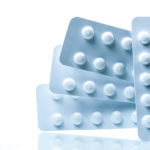The previous day, the patient turned 60, celebrating his birthday with a large meal and a round of golf. Joint pain was unusual for the patient, but six months before, he experienced pain and swelling in his left ankle. With naproxen, the ankle pain resolved after one week.
The patient’s medical history disclosed hypertension, hyperlipidemia and impaired glucose tolerance. On examination, he seemed distressed with the pain and could not bear weight on the right foot. The right, first MTP joint appeared tender, swollen, warm and red. Although the other joints appeared normal on examination, a small white tophus existed on the helix of the left ear.
Laboratory tests showed a C-reactive protein of 68 mg/L (reference range [RR]: <5 mg/L), neutrophils of 12,300 cells/μL (RR: 1,900–75,000 cells/μL) and serum urate of 8.0 mg/dL (RR: 3.3–7.0 mg/dL). Point-of-care ultrasound revealed a double contour sign, grade 3 synovial hypertrophy and a color Doppler signal at the right first MTP joint. The left first MTP joint presented with a double contour sign, a tophus and bone erosion at the medial metatarsal head.
After a diagnosis of gout flare, the patient was prescribed 40 mg of prednisone daily for one week, resulting in clinical improvement and symptom resolution over 10 days. Considering the patient’s recurrent gout flares and presence of tophi, he was prescribed urate-lowering therapy—100 mg of allopurinol daily gradually increasing to 400 mg daily—which reduced the serum urate to 5.2 mg/dL. In the first six months of allopurinol treatment, the patient was also prescribed low-dose colchicine (0.6 mg daily) to prevent recurrent gout flares.
Over the first year of allopurinol treatment, the patient continued to experience mild gout flares, which were managed by a home supply of prednisone. At three years of allopurinol treatment, the patient was free of gout flares for longer than a year and the tophus on his ear had resolved. He was pain free and able to exercise regularly.
Therapeutic Interventions
The mainstay of gout flare treatment is anti-inflammatory medications, such as non-steroidal anti-inflammatory drugs (NSAIDs), colchicine and glucocorticoids.
“While NSAIDs inhibit inflammatory mediator production downstream of the NLRP3 inflammasome, both colchicine and glucocorticoids inhibit the activity of the NLRP3 inflammasome, although by different mechanisms,” Dr. Dalbeth says. Colchicine and glucocorticoids “also inhibit neutrophil and other immune cell recruitment and inflammatory cytokine production, exerting wide-ranging effects to dampen immune activity and inflammation. Despite the differences in modes of action, NSAIDs, colchicine and glucocorticoids have similar clinical efficacy for treatment of the gout flare.
